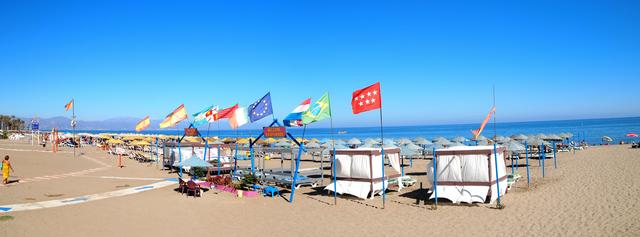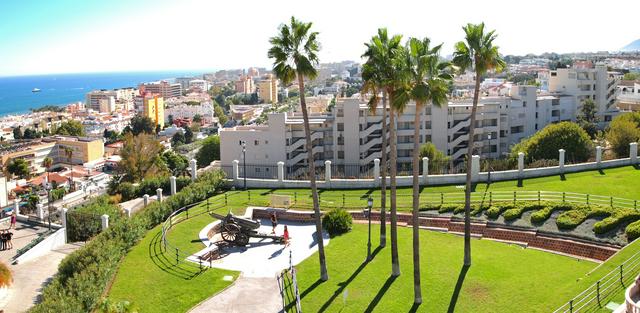Torremolinos is a town on the Costa del Sol in southern Spain. It is approximately 12 km south of Malaga located between Malaga Bay and the Mijas Mountains.
Torremolinos was originally a fishing village back in the 1920s, but has been rapidly overtaken by tourism. Its nominal population is around 43,000 but this can rise to 250,000 during the tourist season.
Tourists will be most familiar with the beaches of Torremolinos and the pedestrian-only Calle San Miguel, which is lined with shops, and runs from the center of town down to the beach. The lower half is a winding stair-stepped path, and is fun to descend and fortifying to climb!
Beginning in the late 1980s, Torremolinos developed a well-deserved reputation among tourists as being the armpit of the Costa del Sol. An angry, tourism-dependent community affected some changes at Town Hall, and new priorities were put in place. Today, Torremolinos is once again an attractive, clean, safe haven for northern Europeans escaping the fiercer climes for the sunniest spot in Europe. It is also one of the most popular resorts for Spanish tourists, with some of the districts (especially La Carihuela) having as much of a Spanish feel as an international tourist one.
 Torremolinos is made up of several distinct districts stretching either side of the Town Centre: El Bajondillo is the beach area closest to the town, east of here are the commercial tourist area of Playamar (home of the infamous high-rise hotels from the 60s and 70s) and then the pleasant beach-side district of Los Alamos. West of the Town Centre lie La Carihuela - the old fishing village, of which some architecture survives, and then Montemar which adjoins the neighbouring municipality of Benalmádena.
Torremolinos is made up of several distinct districts stretching either side of the Town Centre: El Bajondillo is the beach area closest to the town, east of here are the commercial tourist area of Playamar (home of the infamous high-rise hotels from the 60s and 70s) and then the pleasant beach-side district of Los Alamos. West of the Town Centre lie La Carihuela - the old fishing village, of which some architecture survives, and then Montemar which adjoins the neighbouring municipality of Benalmádena.
La Carihuela is famous throughout Spain as a major centre of Andalucian cuisine, with the emphasis being heavily on seafood of all kinds. The old fishing village has been pedestrianised and runs parallel to one of the best beaches on the Costa del Sol. It is in La Carihuela that the tourist boom began in the 1950s with the arrival of the jet set, including Frank Sinatra and friends.
While summer is the peak season for visiting, winters here are also mild by European standards, with temperatures rarely falling below 10°C. For those who want peace and quiet, winter is a good time to visit as Torremolinos turns into a ghost town, but with temperatures comfortable enough to offer respite from the bitter winters in the rest of Europe.
Since the beginning of its tourism surge in the late 1950s, Torremolinos has been a safe haven for Europe's gay and lesbian holiday makers. Even under Franco, while gay people elsewhere in Spain were being brutalized, imprisoned and executed, the value of the solid currencies that the so called vacationing "deviants" brought into Spain's faltering economy trumped whatever personal feelings Franco had about same sex relationships and kept Torremolinos a gay Mecca, long before the word "gay" evolved into common usage.
Today, gay life in Torremolinos centers around the Nogalera complex in the very center of town where there is a gay bar to suit just about every taste one can imagine. The complex itself is very mixed, with gay and family restaurants, bars and shops, all jumbled together, making for a nice, comfortable ambiance. Given the "macho" reputation of Spanish culture, many first-time lgbt visitors are surprised to discover the general indifference of the locals to sexual orientation. Check out Torremolinos Gay Community pages for current agenda.
- La Carihuela. fishermans quarter
- La Carihuela. beach
- Crocodile park, C/ Cuba, 14, +34 952051782.
- Municipal Auditorium Principe de Asturias, C/ Pedro Navarro Bruna s/n. It is one of the biggest auditoriums in Andalucia. Used mainly for classical concerts, ballet, theater and all types of cultural events.

- Parque de la Batería, Ramal del Carmelo. Inside the park is tower Torre Mirador, from which is a good view towards the sea/town.
- Parish church of San Miguel Arcángel.
- Torre de Pimentel.
- Casa de los Navaja.
Parish church of San Miguel Arcángel.
Torre de Pimentel.
Casa de los Navaja.
La Carihuela. fishermans quarter
La Carihuela. beach
Crocodile park, C/ Cuba, 14, +34 952051782.
Municipal Auditorium Principe de Asturias, C/ Pedro Navarro Bruna s/n. It is one of the biggest auditoriums in Andalucia. Used mainly for classical concerts, ballet, theater and all types of cultural events.
Parque de la Batería, Ramal del Carmelo. Inside the park is tower Torre Mirador, from which is a good view towards the sea/town.
- Aqualand - A water park claims to be the biggest in Andalucia. It is located about 10 min. from the town center.
- Windsurfing
- Kitesurfing
- Water skiing
- Pedal boats
- Boat trips - These can include dolphin watching and tend to depart from Benalm%C3%A1dena marina
- Semana Santa (Holy Week) the week before Easter Sunday. Processions through Torremolinos on Maundy Thursday and Good Friday. Torremolinos is a good base for visiting the spectacular daily Semana Santa processions in nearby Málaga (the largest outside Seville) as the frequent train service means avoiding the traffic-chaos in central Málaga.
- Fried Fish Day (Dia del Pescaito) takes place every year on the first Thursday in June. It takes place on La Carihuela Beach on the south western side of the resort.
- Festival of the Virgen del Carmen de La Carihuela on July 16th every year. The climax to the Feria de La Carihuela this includes the procession of the image of the Virgen from the small church in La Carihuela through the streets and down to the seafront, from where she tours the other beaches of Torremolinos.
- Festival of San Miguel Arcángel. Last week in September, culminating on St Michael's Day, September 29th. A very busy week-long festival of processions, parades and events. San Miguel is the patron saint of Torremolinos.
Semana Santa (Holy Week) the week before Easter Sunday. Processions through Torremolinos on Maundy Thursday and Good Friday. Torremolinos is a good base for visiting the spectacular daily Semana Santa processions in nearby [[Málaga]] (the largest outside [[Seville]]) as the frequent train service means avoiding the traffic-chaos in central Málaga.
Fried Fish Day (Dia del Pescaito) takes place every year on the first Thursday in June. It takes place on La Carihuela Beach on the south western side of the resort.
Festival of the Virgen del Carmen de La Carihuela on July 16th every year. The climax to the Feria de La Carihuela this includes the procession of the image of the Virgen from the small church in La Carihuela through the streets and down to the seafront, from where she tours the other beaches of Torremolinos.
Festival of San Miguel Arcángel. Last week in September, culminating on St Michael's Day, September 29th. A very busy week-long festival of processions, parades and events. San Miguel is the patron saint of Torremolinos.
Aqualand - A water park claims to be the biggest in Andalucia. It is located about 10 min. from the town center.
Windsurfing
Kitesurfing
Water skiing
Pedal boats
Boat trips - These can include dolphin watching and tend to depart from [[Benalm%C3%A1dena]] marina
The revitalised Torremolinos Town Centre is now home to many national and international chain stores as well as the usual tourist shops. It's increasing popularity with Spanish tourists means that many of the old 'tat-shops' have now been replaced with designer boutiques. A surprisingly good variety of shopping is available if you explore the little side streets and alleys off Calle San Miguel, the main shopping street.
- There is a huge range of restaurants, especially in the La Carihuela district.
- Fresh pescaíto frito stands can be found along the beaches Torremolinos Restaurant Guide provides lots of reviews of the restaurants within Torremolinos
As a major Spanish and international tourist destination Torremolinos has cafés, bars and café-bars to suit all tastes. It is also the home of the famous 'chiringuitos' - beach café-bars which offer beach-side drinks and meals throughout the year. The best of these are to be found in the district of La Carihuela.
Sample the local vino de Málaga, a fortified wine similar to sherry.
- La Cervezateca, Calle Casablanca 22 (Opposite Pueblo Blanco. 6PM-2AM. An oasis in the Spanish Beer Desert. More than 100 beers from around the world, including 6 trappist beers.
La Cervezateca, Calle Casablanca 22 (Opposite Pueblo Blanco. 6PM-2AM. An oasis in the Spanish Beer Desert. More than 100 beers from around the world, including 6 trappist beers.
Torremolinos is well-placed as a base for visiting the various sights of Andalucía, connected by efficient public transport to much of the Costa de Sol. There are many excursion shops offering 'all-in' day trips too.
- The mountain village of Mijas -famous for its white-washed houses.
- The city of Málaga with its Moorish Castle, Picasso Museum etc.
- Marbella with its famous Old Town and chic shopping.
- The marina at Benalmádena with yacht-hire, fishing trips etc.
- Seville, Granada, and Córdoba are all easily reached by connecting train from Málaga
